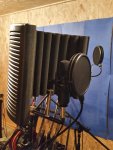I know there's information here somewhere about making your own vocal booth, but I couldn't find it in a search.
My current studio is 11x12 - basically an extra bedroom of the house. Wood flooring, one window (no curtains at this point), no wall treatments, and 10' ceilings I think. Voice is the only acoustic instrument I'm using - the rest can be done with MIDI or a direct audio line into the computer. I know that for mixing purposes I'll need to treat the room eventually, but for right now, I need to be able to get some good clean vocal tracks.
So a DIY booth that I can set up and disassemble when needed is a must. I have a big voice, being operatically trained, so that may come into play as to the size of the booth a little, but I don't plan on singing any opera in there. For the operatic vocals I'll have to record in a much larger space I think.
Hubby is very handy and we have lots of tools, so it doesn't need to be overly simple - although if simple is best, we'll do that.
What do you recommend?
My current studio is 11x12 - basically an extra bedroom of the house. Wood flooring, one window (no curtains at this point), no wall treatments, and 10' ceilings I think. Voice is the only acoustic instrument I'm using - the rest can be done with MIDI or a direct audio line into the computer. I know that for mixing purposes I'll need to treat the room eventually, but for right now, I need to be able to get some good clean vocal tracks.
So a DIY booth that I can set up and disassemble when needed is a must. I have a big voice, being operatically trained, so that may come into play as to the size of the booth a little, but I don't plan on singing any opera in there. For the operatic vocals I'll have to record in a much larger space I think.
Hubby is very handy and we have lots of tools, so it doesn't need to be overly simple - although if simple is best, we'll do that.

What do you recommend?

 . I bought it used and wish I'd forked over the extra for new.
. I bought it used and wish I'd forked over the extra for new. 

